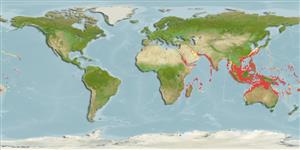Environment: milieu / climate zone / depth range / distribution range
Οικολογία
Θαλασσινό(ά) Υφαλόφιλο(α); μη μεταναστευτικό(ά); εύρος βάθους 2 - 150 m (Ref. 9710). Tropical; 35°N - 32°S, 30°E - 156°W (Ref. 5222)
Indo-Pacific: Red Sea to Durban, South Africa and eastward to the Line Islands; including most islands in the Indian and west-central Pacific oceans. Absent from Persian Gulf and Gulf of Oman. Misidentified as Cephalopholis cyanostigma from Reunion (Ref. 6453).
Length at first maturity / Μέγεθος / Βάρος / Age
Maturity: Lm ?, range 26 - ? cm
Max length : 50.0 cm TL αρσενικό/απροσδιόριστο; (Ref. 90102)
Ραχιαίες άκανθες (συνολικά) : 9; Μαλακές ραχιαίες ακτίνες (συνολικά) : 14 - 15; Εδρικές άκανθες: 3; Μαλακές εδρικές ακτίνες: 8 - 9. Color orange-red to reddish brown, usually dark posteriorly with numerous bright blue spots which are smaller than the pupil and often faintly dark-edged on head, body and median fins; distal margin of caudal fin and soft portions of dorsal and anal fins usually with a narrow blue margin and blackish submarginal line; orange-yellow pectoral fins, on some only distally; orange-red pelvic fins; it is capable of a disruptive color pattern of irregular oblique olivaceous bars; juveniles may be yellow with scattered faint blue spots. D IX, 14-16; A III, 8-9 (rarely 8); pectoral 17-18 (often 18); scales on lateral line 47-55; scales on longitudinal series 94-114; snout anterior to nostrils no scales; partially scaled maxilla; abdomen with cycloid scales; gill rakers 7-9 + 13-15; depth of body 2.65-3.05 in SL; length of head 2.4-2.65 in SL; the maxilla extends to or posterior to rear of the orbit; smooth ventral margin of preopercle; 5th - 8th dorsal spines longest , 3.0-3.6 in head; pectoral fins 1.45-1.75 in head; pelvic fins do not reach the anus, 1.9-2.3 in head (Ref. 4787).
Inhabit clear waters of coral reefs; more often found in exposed rather than protected reef areas (Ref. 5213). Feed on fishes (80%, mainly Pseudanthias squamipinnis) and crustaceans. Form haremic groups comprising of a dominant male and 2 to 12 females. These groups occupy territories of up to 475 sq m subdivided into secondary territories and defended by a single female (Ref. 6480). Generally common (Ref. 9710).
Life cycle and mating behavior
Γεννητική Ωρίμανση | Αναπαραγωγή | Γεννοβολία | Αβγά | Γονιμότητα | Προνύμφες
Heemstra, P.C. and J.E. Randall, 1993. FAO Species Catalogue. Vol. 16. Groupers of the world (family Serranidae, subfamily Epinephelinae). An annotated and illustrated catalogue of the grouper, rockcod, hind, coral grouper and lyretail species known to date. Rome: FAO. FAO Fish. Synop. 125(16):382 p. (Ref. 5222)
IUCN Red List Status (Ref. 130435: Version 2024-2)
Threat to humans
Harmless
Human uses
αλιεία: Εμπορικό(ά); αλιεία αναψυχής: ναί; Ενυδρείο: Εμπορικό(ά)
Εργαλεία
Special reports
Download XML
Διαδικτυακές πηγές
Estimates based on models
Preferred temperature (Ref.
123201): 23.7 - 29, mean 27.8 °C (based on 2104 cells).
Phylogenetic diversity index (Ref.
82804): PD
50 = 0.5000 [Uniqueness, from 0.5 = low to 2.0 = high].
Bayesian length-weight: a=0.01072 (0.00714 - 0.01608), b=3.06 (2.94 - 3.18), in cm total length, based on LWR estimates for this species & Genus-body shape (Ref.
93245).
Τροφικό Επίπεδο (Ref.
69278): 4.3 ±0.5 se; based on diet studies.
Generation time: 11.0 ( na - na) years. Estimated as median ln(3)/K based on 2
growth studies.
Ελαστικότητα (Ref.
120179): Χαμηλό, ελάχιστος χρόνος για διπλασιασμό πληθυσμού 4,5 - 14 έτη (tmax=30; K=0.101).
Fishing Vulnerability (Ref.
59153): High to very high vulnerability (65 of 100).
Climate Vulnerability (Ref.
125649): High vulnerability (57 of 100).
Nutrients (Ref.
124155): Calcium = 33.1 [19.0, 56.1] mg/100g; Iron = 0.462 [0.261, 0.873] mg/100g; Protein = 18.3 [16.5, 20.0] %; Omega3 = 0.165 [0.105, 0.264] g/100g; Selenium = 43.7 [24.0, 79.0] μg/100g; VitaminA = 189 [61, 665] μg/100g; Zinc = 0.783 [0.546, 1.236] mg/100g (wet weight); based on
nutrient studies.
